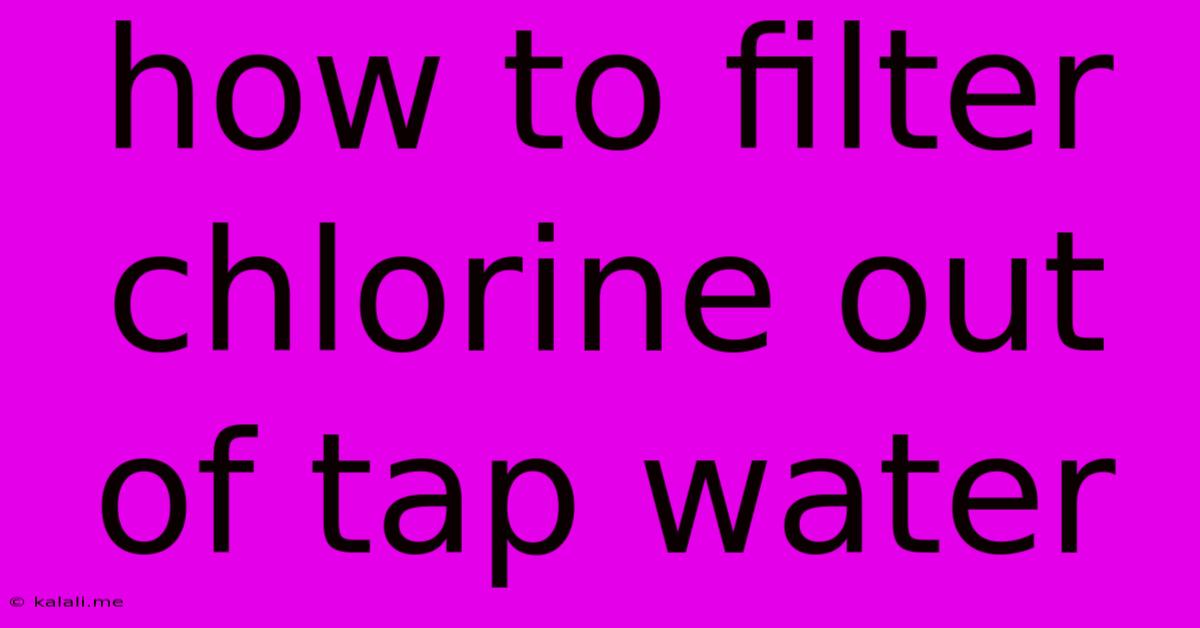How To Filter Chlorine Out Of Tap Water
Kalali
Jun 06, 2025 · 3 min read

Table of Contents
How to Filter Chlorine Out of Tap Water: A Comprehensive Guide
Chlorine is a common disinfectant added to tap water to kill harmful bacteria and viruses. While effective at protecting public health, many find the taste and smell of chlorine objectionable. Furthermore, some are concerned about potential long-term health effects of chlorine exposure. This guide explores effective methods for removing chlorine from your tap water, allowing you to enjoy cleaner, better-tasting water. We'll cover various filtering options, from simple and affordable solutions to more advanced systems.
Understanding Chlorine in Tap Water
Before delving into filtration methods, it's crucial to understand why chlorine is present and its potential impact. Municipal water treatment plants use chlorination as a final step to ensure the water reaching your home is safe to drink. However, this process can leave behind residual chlorine, which manifests as a noticeable taste and smell. While the concentration is generally within safe limits, reducing chlorine levels can improve the overall palatability and potentially minimize exposure.
Simple and Affordable Methods for Chlorine Removal
These methods are great for immediate needs or situations where a permanent filtration system isn't feasible:
- Boiling: Boiling water for at least one minute will volatilize most of the chlorine, making it escape as a gas. This is a simple and effective method for small quantities of water. However, it doesn't remove other potential contaminants.
- Letting it Sit: Simply letting tap water sit in an open container for 12-24 hours can allow a significant portion of the chlorine to dissipate into the air. This passive approach requires patience but is cost-effective. Keep in mind that this doesn't remove other impurities.
- Using a Shower Filter: Chlorine is also present in shower water, and can dry skin and hair. A simple shower filter can significantly reduce chlorine exposure during showering. These are relatively inexpensive and easy to install.
Advanced Filtration Systems for Chlorine Removal
For a more permanent and comprehensive solution, consider these advanced filtration methods:
- Activated Carbon Filters (Carbon Filters): These filters are highly effective at adsorbing chlorine and other volatile organic compounds (VOCs). They are commonly found in pitcher filters, faucet-mounted filters, and whole-house filtration systems. Regular replacement of the carbon filter is essential to maintain effectiveness. Look for filters specifically designed for chlorine removal.
- Reverse Osmosis (RO) Systems: RO systems utilize a semi-permeable membrane to filter out a wide range of contaminants, including chlorine. While highly effective, they are more expensive and require regular maintenance, including filter changes and potential waste water disposal considerations.
- Distillation: Distillation involves boiling water and then collecting the condensed steam. This process removes chlorine and many other impurities. While effective, it is energy-intensive and not practical for daily use.
Choosing the Right Chlorine Filter for Your Needs
The best method for removing chlorine depends on your individual needs and budget. Consider the following factors:
- Water usage: If you only need to filter a small amount of water occasionally, a pitcher filter or boiling may suffice. For larger volumes, a faucet-mounted filter or a whole-house system would be more appropriate.
- Budget: Pitcher filters and shower filters are the most affordable options. Faucet-mounted filters and whole-house systems are more expensive but offer greater convenience.
- Desired level of filtration: If you're only concerned about chlorine, a carbon filter might be sufficient. If you want to remove other contaminants as well, an RO system might be a better choice.
By carefully considering these factors, you can select the most effective and cost-efficient way to remove chlorine from your tap water and enjoy cleaner, fresher, and better-tasting water. Remember to always check the filter specifications and follow the manufacturer's instructions for optimal performance and longevity.
Latest Posts
Latest Posts
-
Can You Start A Car On Jack Stands
Jun 06, 2025
-
When An Opponent Loses Life You Gain Life
Jun 06, 2025
-
How To Add Music To Your Ipod Without Itunes
Jun 06, 2025
-
Why Is My Female Dog Licking Everything
Jun 06, 2025
-
Does Olive Oil Solidify In The Fridge
Jun 06, 2025
Related Post
Thank you for visiting our website which covers about How To Filter Chlorine Out Of Tap Water . We hope the information provided has been useful to you. Feel free to contact us if you have any questions or need further assistance. See you next time and don't miss to bookmark.